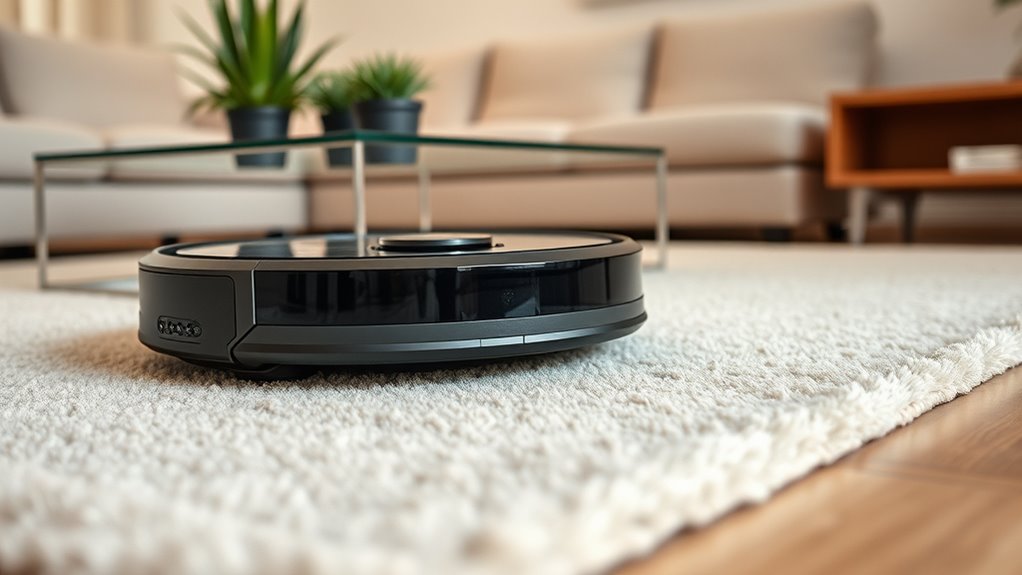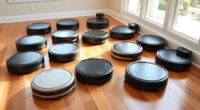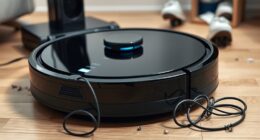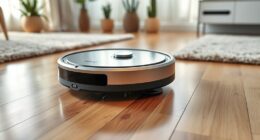To select the ideal robot vacuum, consider your home’s size and daily routines. Longer battery life is optimal for larger spaces or frequent use, while quieter models suit households with kids or work-from-home setups. Match features like battery capacity and noise levels to your household needs to guarantee efficient and peaceful cleaning. By understanding these factors, you’ll find a model that keeps your home spotless and fits seamlessly into your lifestyle—continue to discover how to make the best choice.
Key Takeaways
- Assess your home’s size and layout to determine the necessary battery capacity for uninterrupted cleaning sessions.
- Consider noise levels, aiming for models below 60 dB to ensure quiet operation during daily activities.
- Match features like battery life and noise reduction to household needs, such as pets, children, or work-from-home routines.
- Prioritize models with quick-charging or long-lasting batteries to reduce downtime and maintain consistent cleanliness.
- Choose a vacuum that balances performance and noise to seamlessly fit into your home environment and lifestyle.
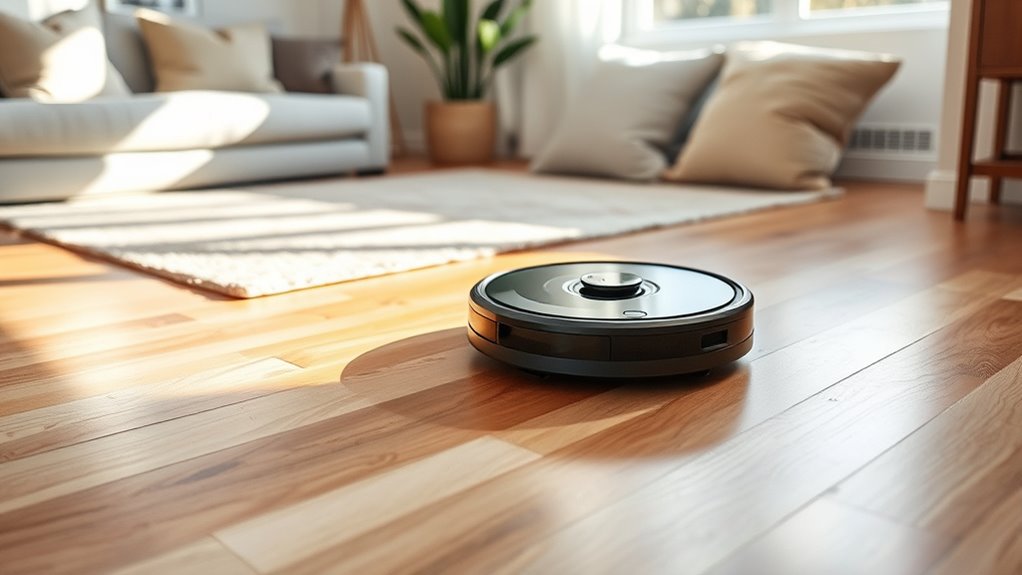
Choosing the right robot vacuum can considerably simplify your cleaning routine, but with so many options available, it’s easy to feel overwhelmed. One of the most important factors to take into account is battery life. You want a vacuum that can handle the size of your home without needing a recharge halfway through. If you have a large space or multiple rooms, look for models with longer battery life—these can clean more thoroughly without interruptions. On the other hand, if your space is small, a shorter battery span might suffice, and you could benefit from a more affordable or lightweight option. Keep in mind that some robot vacuums have quick-charging features, allowing them to return to their dock and recharge rapidly, so they can complete larger cleaning jobs in less time.
Choose a robot vacuum with long battery life for larger homes and quick recharging for efficiency.
Noise levels are another crucial aspect often overlooked. While robot vacuums are generally quieter than traditional vacuum cleaners, some models produce more noise than others. If you live in a household where quiet operation matters—say, you work from home, have young children, or prefer to run your vacuum while sleeping—pay close attention to noise ratings. Many manufacturers provide decibel levels in their specifications; aim for models that operate below 60 decibels for minimal disruption. Some premium models even feature noise-reduction technology, making them nearly silent during operation. Choosing a quieter vacuum means you can run it during the day, while you’re busy with other activities, without disturbing your peace.
When evaluating battery life and noise levels, think about your daily routine and household needs. For example, if you have pets that shed frequently, you’ll want a vacuum with both a long-lasting battery and efficient cleaning capabilities to cover your entire home in one run. If you work from home or have young children, a quieter model will let you focus or rest without constant background noise. The balance between these factors often depends on your specific environment—so prioritize what matters most. Additionally, some models in the Kia Tuning lineup offer enhanced performance features that could be compared to choosing a more powerful or upgraded vacuum for better results.
Ultimately, selecting a robot vacuum with suitable battery life and noise levels ensures you get a device that fits seamlessly into your lifestyle. A model with adequate battery capacity will keep your home clean without constant recharging, while a quieter operation means no more disruptions during your daily activities. By keeping these considerations in mind, you’ll find a vacuum that not only cleans effectively but also integrates smoothly into your home life, saving you time and effort in the long run.
Frequently Asked Questions
How Often Should I Schedule My Robot Vacuum to Run?
You should consider your home’s cleaning needs when deciding on scheduling frequency. For daily cleaning, set shorter intervals, especially in high-traffic areas. If your space isn’t as busy, weekly or bi-weekly cleaning intervals might suffice. Adjust based on dust levels, pet hair, and allergies. Regular scheduling guarantees your floors stay cleaner and reduces manual vacuuming, making your routine easier and more efficient.
Can Robot Vacuums Clean Carpets and Hardwood Floors Effectively?
Robot vacuums can clean carpets and hardwood floors effectively if they have strong cleaning power and good floor compatibility. Look for models with adjustable brushes and suction settings to handle different surfaces. Carpets require more suction, while hardwood floors benefit from gentle cleaning to avoid scratches. With the right features, your robot vacuum will efficiently tackle both types of flooring, making your cleaning routine easier and more thorough.
What Is the Average Lifespan of a Robot Vacuum?
You might wonder about a robot vacuum’s lifespan. On average, it lasts about 2 to 3 years, depending on usage, battery life, and maintenance. Regularly replacing batteries can extend its life, but repair costs may rise after that period. Proper care helps optimize performance, ensuring your vacuum cleans effectively and lasts longer, saving you money and hassle over time.
Are Robot Vacuums Safe for Homes With Pets?
Robot vacuums are generally safe for homes with pets, but you should consider pet safety and allergy concerns. Look for models with gentle brushes and HEPA filters to reduce pet hair and allergens in the air. Always supervise initially to ensure your pets aren’t scared or distressed. Regularly empty the dustbin and clean filters to maintain effective pet safety and minimize allergy issues, making your home cleaner and healthier for everyone.
How Do I Maintain and Troubleshoot My Robot Vacuum?
Think of maintaining your robot vacuum like tending a garden—you need to prune and nurture it regularly. To keep it in top shape, clean the brushes often and check the battery life. If your vacuum isn’t charging properly, consider a battery replacement. Troubleshoot issues by clearing blockages and resetting the device. Regular upkeep guarantees your robot stays a loyal helper, keeping your floors spotless without a hitch.
Conclusion
Choosing the right robot vacuum might seem overwhelming, but it all comes down to understanding your home’s needs and your lifestyle. When you pick the perfect match, you’ll find that cleaning becomes effortless—almost like magic. It’s funny how finding the right device can suddenly make your home feel fresher and more inviting, almost like it was meant to be. Trust your instincts, and you’ll discover that the perfect robot vacuum is closer than you think.
